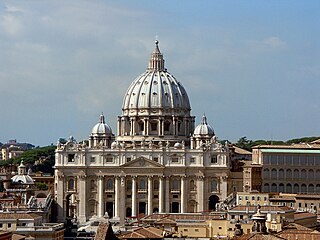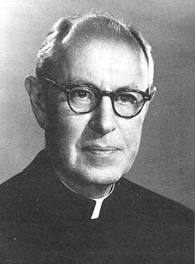
The Second Ecumenical Council of the Vatican, commonly known as the Second Vatican Council or Vatican II, was the 21st and most recent ecumenical council of the Catholic Church. The council met in Saint Peter's Basilica in Vatican City for four periods, each lasting between 8 and 12 weeks, in the autumn of each of the four years 1962 to 1965.

The University of Notre Dame du Lac, known simply as Notre Dame, is a private Catholic research university in Notre Dame, Indiana. Founded in 1842 by members of the clerical Congregation of Holy Cross, the main campus of 1,261 acres has a suburban setting and contains landmarks such as the Golden Dome, the Word of Life mural, Notre Dame Stadium, and the basilica.

Theodore Martin Hesburgh, CSC was an American Catholic priest and academic who was a member of the Congregation of Holy Cross. He is best known for his service as the president of the University of Notre Dame for thirty-five years (1952–1987).

John Courtney Murray was an American Jesuit priest and theologian who was especially known for his efforts to reconcile Catholicism and religious pluralism and particularly focused on the relationship between religious freedom and the institutions of a democratically-structured modern state.

The Congregation for Catholic Education (Institutes of Study) (Latin: Congregatio de Institutione Catholica (Studiorum Institutis)) was the pontifical congregation of the Roman Curia responsible for: universities, faculties, institutes and higher schools of study, either ecclesial or non-ecclesiastical dependent on ecclesial persons; and schools and educational institutes depending on ecclesiastical authorities.

Maryvale Institute is a college of further and higher education, an International Catholic Distance-Learning College for Catechesis, Theology, Philosophy and Religious Education in Old Oscott, Great Barr, Birmingham, England. It specialises in the provision of part-time, distance learning courses to the lay faithful, consecrated religious and ministers of the Roman Catholic Church.
The Cardinal Newman Society is an American 501(c)(3) tax-exempt, nonprofit organization founded in 1993 whose stated purpose is to promote and defend faithful Catholic education. The organization is guided by Cardinal John Henry Newman's The Idea of a University and Pope John Paul II's 1990 Apostolic Constitution Ex Corde Ecclesiae. The organization publishes The Newman Guide to Choosing a Catholic College. However, it has been criticized for adopting views that Newman would have opposed.
Rev. Edward Aloysius Malloy, C.S.C. is an American Catholic priest, academic, and former college basketball player who is a member of the Congregation of Holy Cross. Nicknamed “Monk Malloy”, he is best known for his service as the 16th president of the University of Notre Dame from 1987 to 2005.

Richard Peter McBrien was a Catholic priest, theologian, and writer who was the Crowley-O'Brien Professor of Theology at the University of Notre Dame near South Bend, Indiana, U.S. He authored twenty-five books, including the very popular Catholicism, a reference text on the Church after the Second Vatican Council.
Ex corde Ecclesiae is an apostolic constitution issued by Pope John Paul II regarding Catholic colleges and universities. Promulgated on 15 August 1990 and intended to become effective in the academic year starting in 1991, its aim was to define and refine the Catholicism of Catholic institutions of higher education.

Theodore Hesburgh Library is the primary building of the University of Notre Dame's library system. The present-day building opened on September 18, 1963, as Memorial Library. In 1987, it was renamed Hesburgh Library, in honor of Rev. Theodore Hesburgh, C.S.C., who served as the university's president from 1952 to 1987. The library's exterior façade that faces the university's football stadium includes a large, 134-foot (41 m) by 68-foot (21 m) mural called Word of Life, or more commonly known as Touchdown Jesus. As of 2009, the library ranked as the 61st largest collection among research universities in the United States, with an estimated 3.39 million volumes.
St Augustine College of South Africa is a private tertiary academic institution in Johannesburg, South Africa.

"A Catholic Statement on Pluralism and Abortion", alternatively referred to by its pull quote "A Diversity of Opinions Regarding Abortion Exists Among Committed Catholics" or simply "The New York Times ad", was a full-page advertisement placed on October 7, 1984, in The New York Times by Catholics for a Free Choice (CFFC). Its publication brought to a head the conflict between the Vatican and those American Catholics who were in favor of access to abortion. The publicity and controversy which followed its publication helped to make the CFFC an important element of the abortion-rights movement.
The History of Catholic Education in the United States extends from the early colonial era in Louisiana and Maryland to the parochial school system set up in most parishes in the 19th century, to hundreds of colleges, all down to the present.

Tantur Ecumenical Institute is an international ecumenical institute for advanced theological research in Jerusalem.
Veritatis gaudium is an apostolic constitution on ecclesiastical universities and faculties. It was signed by Pope Francis on 8 December 2017 and entered into force on 29 January 2018. It updates the 1979 apostolic constitution Sapientia christiana. The document is 87 pages in length. The new norms took legal effect on the first day of the 2018-2019 academic year or of the 2019 academic year, depending on the school year of particular institutions.

Hesburgh is a 2018 American documentary film directed by Patrick Creadon. The film follows the life of Fr. Theodore Hesburgh, President of the University of Notre Dame from 1952 through 1987, particularly during his time working on the U.S. Commission on Civil Rights. The film is drawn from archival footage, as well as interviews with family, colleagues at Notre Dame, politicians, journalists, and historians. Maurice LaMarche provides the voice of Hesburgh, narrating the documentary with words drawn from Hesburgh's writings and tapes.
Neil Gerard McCluskey, a former Jesuit Catholic priest known as Reverend Neil Gerard McCluskey, S.J. from 1938 to 1975, was a prominent voice for Catholic Education in the United States in the time of Vatican II. McCluskey wrote the famous Land O'Lakes Statement, as a member of the committee headed by Fr. Theodore Hesburgh. McCluskey was also the last surviving nephew of Blessed Solanus Casey.
George Nauman Shuster was an American journalist, author, and educator who was born in Lancaster, Wisconsin in 1894 and died in South Bend, Indiana, on January 25, 1977. Born into German ethnic community, he attended Catholic schools and earned his A.B. degree at the University of Notre Dame in 1915. He served in Army intelligence during World War I. After that he studied at the universities of Poitiers and Berlin. He took a PhD in English literature at Columbia University. He was head of the English department at Notre Dame (1920–24); he taught English at Brooklyn Polytechnic Institute and St. Joseph's College for Women in Brooklyn. (1924–34).
By definition, Catholic canon law states that "A Catholic school is understood to be one which is under control of the competent ecclesiastical authority or of a public ecclesiastical juridical person, or one which in a written document is acknowledged as Catholic by the ecclesiastical authority". Although some schools are deemed "Catholic" because of their identity and a great number of students enrolled are Catholics, it is also stipulated in canon law that "no school, even if it is in fact Catholic, may bear the title 'Catholic school' except by the consent of the competent ecclesiastical authority".